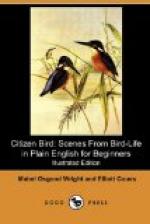“Veeries, yes, but called Wilson’s Thrush, too,” said the Doctor; “because this kind of Thrush was named after Alexander Wilson, who wrote a description of it, and published a colored plate of it, seventy-five years ago. But your name of ‘sunset bird’ is very good, my lad, for they sing best about twilight. We will go down to the river path and hear them, though you cannot see them very clearly now.”
The Wood Thrush
The largest of our Thrushes except the Robin—length about eight inches.
Upper parts warm brown, like ground cinnamon; brightest on the head, but a little greenish on the tail.
Under parts plain white in the middle, but boldly spotted with black all over the breast and along the sides.
Eye-ring whitish.
A Summer Citizen of the eastern United States, and
a Ground Gleaner,
Tree Trapper, and Seed Sower.
WILSON’S THRUSH
Commonly called VEERY from the sound of one of its notes
“How still it is here!” said Dodo, as they walked along the footpath that wound in and out among the trees toward the edge of the river. Swallows were skimming close to the water, which sang a little song to itself as it ran along.
“What do you think those birds are doing, Rap,” said Nat; “looking at themselves in the water or playing tag?”
[Illustration: Veery.]
“They are Barn Swallows, who catch flies and little gnats and things close down over the water. Hear them talking and laughing!” But the Swallows really seemed to be playing some sort of game as they circled about, every now and then turning sharply and giving little rippling cries.
The Doctor halted under a beech tree that spread its branches over a great mossy circle, seating himself on an old log that had been washed down the river and lay on the ground. For a minute the Veeries were silent; then from the tree over his head one sang a short tune—two sentences in a high key, then two a little lower and softer, like an echo.
“It is different from any other bird-song,” said Olive, “and every spring when it comes it seems as lovely as the first time I heard it.” “Is that Veery only visiting here, or will he build a nest?” asked Nat.
“He will build; and though he is so shy that we do not see him as often as the Wood Thrush, his song makes him one of the best-known of the family. He makes his home from the Middle States, east and west, all over the country, up to the far North; but as insects are his chief food he does not come as early or stay as late in his summer home as the Hermit Thrush, and always tries to reach the warmer countries before the trees are wholly bare and there is danger of snow.”
“Do they live up in the trees where they sing?” asked Dodo, after they had listened to the Veeries, who were then singing on both sides of the river.




